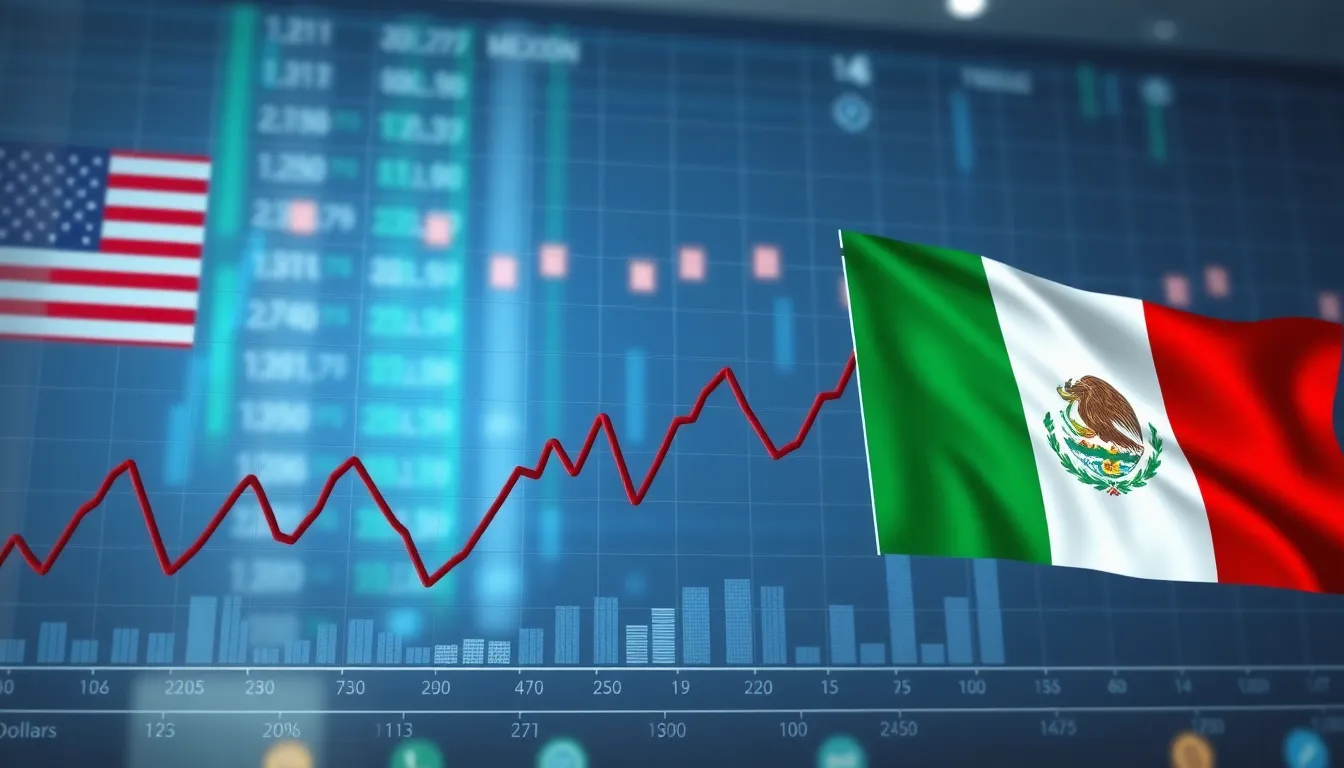The exchange rate between the US dollar and the Mexican peso plays a crucial role in the financial landscape of both countries. As economies become increasingly interconnected, fluctuations in this rate can significantly impact trade, tourism, and investment decisions. Understanding these dynamics is essential for anyone involved in cross-border transactions or simply looking to navigate their finances more effectively.
With the dollar often serving as a benchmark currency, shifts in its value can lead to ripple effects in the peso’s performance. This article explores the current trends and factors influencing the dollar to peso exchange rate, providing insights that can help individuals and businesses make informed decisions in an ever-changing economic environment.
Table of Contents
ToggleOverview of Tipo De Cambio Dolar a Peso Mexicano
The exchange rate between the US dollar (USD) and the Mexican peso (MXN) reflects the value of one currency in terms of the other. Frequent fluctuations in this rate influence multiple sectors, including trade, tourism, and investments.
Key factors impacting the dollar to peso exchange rate include:
- Economic Indicators: Inflation rates, employment figures, and GDP can significantly affect market perceptions of currency strength.
- Interest Rates: Central bank policies in the U.S. and Mexico shape investor behavior by altering returns on investments denominated in each currency.
- Political Stability: Changes in government, policies, or social stability can generate fluctuations based on market confidence.
Current exchange rates vary daily and can be tracked through financial news outlets and platforms that specialize in currency conversion.
Traders and businesses often utilize the exchange rate for decision-making. Understanding these rates aids in budgeting for international transactions and managing investments.
Factors Influencing Exchange Rate

Multiple elements influence the exchange rate between the US dollar and the Mexican peso. Understanding these factors aids in grasping the dynamics of international finance.
Economic Indicators
Economic indicators play a critical role in shaping exchange rate fluctuations. Metrics such as inflation rates, gross domestic product (GDP) growth, and employment statistics influence investor confidence and currency strength. For instance, higher inflation in Mexico relative to the U.S. may devalue the peso against the dollar. Similarly, robust GDP growth in the U.S. often leads to a stronger dollar, affecting the purchasing power of the peso. Tracking these indicators enables traders and investors to make informed decisions.
Political Stability
Political stability significantly impacts currency values and exchange rates. Countries experiencing political unrest or uncertainty can see their currency depreciate as investors seek safer assets. For example, elections or policy changes in Mexico that create uncertainty can lead to depreciation of the peso against the dollar. Conversely, stable governance and predictable policies strengthen investor confidence, often leading to a stronger currency. Monitoring political developments is essential for assessing potential impacts on exchange rates.
Historical Trends
The exchange rate between the US dollar and the Mexican peso has experienced notable fluctuations over the years. Understanding these historical trends provides insights into the economic factors influencing currency valuation.
Past Performance of the Exchange Rate
The dollar to peso exchange rate has varied significantly since the 1980s. For instance:
| Year | Exchange Rate |
|---|---|
| 1980 | 22.50 |
| 1994 | 3.70 |
| 2000 | 9.50 |
| 2010 | 12.50 |
| 2020 | 22.16 |
| 2023 | 18.50 |
The 1994 peso crisis marked a significant depreciation of the peso due to economic instability. The subsequent recovery saw the peso strengthen against the dollar, reflecting improved economic conditions. Over the past decade, the exchange rate fluctuated between 18 and 25 pesos per dollar, influenced by various domestic and international factors.
Significant Events Impacting the Rate
Key events have shaped the dollar to peso exchange rate throughout the years. Significant occurrences include:
- NAFTA Implementation (1994): The North American Free Trade Agreement enhanced trade, increasing demand for the peso and contributing to its rise in value.
- Financial Crisis (2008): The global financial crisis triggered a flight to safety, appreciating the dollar while depreciating the peso significantly.
- COVID-19 Pandemic (2020): Economic uncertainty caused sharp fluctuations, with the peso hitting historic lows against the dollar due to decreased tourism and investment.
- Political Changes: Changes in government policies and political stability influence market confidence. For example, reform initiatives can attract foreign investment, strengthening the peso.
Monitoring these historical trends and events provides a comprehensive view of the factors affecting the dollar to peso exchange rate.
Current Exchange Rate Analysis
Current exchange rates provide valuable insights into the economic landscape between currencies like the US dollar and Mexican peso. Analyzing these rates reveals trends and potential future movements essential for individuals and businesses.
Comparisons with Other Currencies
Comparing the dollar to peso exchange rate with other major currencies enhances understanding of relative value. For instance, the euro to peso rate offers insights into European market dynamics, while the pound sterling’s relation to the peso reflects trade ties with the UK. Recent trends indicate that fluctuations against the euro show the peso’s sensitivity to shifts in European economic health, while changes against the yen highlight trade relations with Asia. Tracking these rates helps gauge the peso’s strength across multiple economic contexts.
Forecasting the Future Rate
Forecasting the future exchange rate involves analyzing various economic indicators and global events. Experts rely on inflation rates, interest rate adjustments by the Bank of Mexico, and geopolitical stability to predict movements. For example, if the US Federal Reserve raises interest rates, it often strengthens the dollar against the peso. Conversely, signs of political unrest in Mexico may weaken the peso’s value. Monitoring these factors allows investors to anticipate changes and make informed financial decisions.
Understanding the dollar to peso exchange rate is essential for anyone involved in cross-border transactions or financial planning. The interplay of economic indicators political stability and historical trends shapes this dynamic relationship. By staying informed about these factors individuals and businesses can navigate the complexities of currency fluctuations more effectively.
Keeping an eye on current rates and market trends helps in making strategic financial decisions. Whether it’s budgeting for travel investing in foreign markets or managing imports and exports awareness of the exchange rate’s impact is crucial. In a rapidly changing global economy the ability to anticipate shifts in the dollar-peso relationship can provide a competitive edge.





